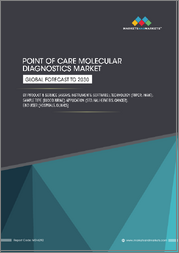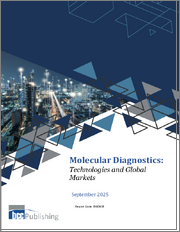
|
시장보고서
상품코드
1610890
분자진단 : 시장 인사이트, 경쟁 환경, 시장 예측(-2030년)Molecular Diagnostic - Market Insights, Competitive Landscape, and Market Forecast - 2030 |
||||||
분자진단 시장 규모는 2023년 95억 6,000만 달러에서 예측 기간 중 CAGR 9.21%로 추이하며, 2030년에는 161억 2,000만 달러 규모로 성장할 것으로 예측됩니다.
분자진단 시장은 HIV, B형 간염, C형 간염, 인플루엔자, 인유두종바이러스(HPV) 등 감염증 환자의 증가, 주요 기업의 혁신적인 신제품 출시 등으로 큰 폭의 성장세를 보이고 있으며, 이러한 요인들은 2024-2030년 시장을 촉진할 것으로 예상됩니다.
분자진단 : 시장 역학
세계보건기구(WHO)의 2024년 발표에 따르면 2022년에는 전 세계에서 약 3,900만 명의 HIV 감염자가 있을 것으로 보고되고 있습니다. 이중 약 3,750만 명이 성인(15세 이상), 약 150만 명이 15세 미만 소아로 추정됩니다. 분자진단은 HIV의 조기 발견, 바이러스 양 모니터링, 약제 내성 변이 확인에 필수적입니다. 이러한 검사는 특히 소아 및 성인과 같은 취약한 집단에서 치료 효과를 평가하고, 치료 방침을 결정하고, 전염을 예방하는 데 도움이 됩니다.
또한 WHO의 2024년 자료에 따르면 2022년 전 세계 B형 및 C형 간염 감염자 수는 3억 4천만 명에 달할 것으로 보고되고 있습니다. 이 중 2억 5,400만 명이 B형 간염, 5,000만 명이 C형 간염에 감염된 것으로 추정됩니다. 분자진단은 바이러스 감염을 조기에 정확하게 식별할 수 있게 함으로써 B형 간염과 C형 간염의 검출 및 관리에 중요한 역할을 하며, PCR과 같은 기술은 혈액 검체에서 바이러스 DNA와 RNA를 검출하는 데 사용되어 임상의가 활성 감염을 확인하고 바이러스 양을 모니터링하고 치료 효과를 평가할 수 있게 한다, 치료 효과를 평가할 수 있습니다.
이러한 모든 요인들이 예측 기간 중 시장을 촉진할 것으로 예상됩니다.
세계의 분자진단 시장을 조사했으며, 시장 개요, 시장 영향요인 및 시장 기회 분석, 법규제 환경, 시장 규모 추이·예측, 각종 구분·지역/주요 국가별 상세 분석, 경쟁 구도, 주요 기업의 개요 등을 정리하여 전해드립니다.
목차
제1장 분자진단 시장 보고서 : 서론
- 조사 범위
- 시장 세분화
- 시장의 전제
제2장 분자진단 시장 : 개요
- 시장 개요
제3장 경쟁 구도
제4장 규제 분석
- 미국
- 유럽
- 일본
- 중국
제5장 분자진단 시장 : 주요 요인 분석
- 시장 성장 촉진요인
- 감염증 및 만성질환의 증가
- 제품 개발 활동의 활발화
- 시장 성장 억제요인과 과제
- 대체 진단 방법의 가용성
- 분자진단 시술에 수반하는 고비용성
- 시장 기회
- AI와 ML의 통합에 의한 데이터 해석의 강화
제6장 분자진단 시장 : Porter's Five Forces 분석
제7장 분자진단 시장 평가
- 제품 유형별
- 기기
- 시약
- 기타
- 기술별
- 중합효소 연쇄 반응(PCR)
- 시퀀싱
- In Situ 하이브리다이제이션
- 마이크로어레이 해석
- 용도별
- 감염증 진단
- 종양학 연구
- 유전자 연구
- 최종사용자별
- 병원
- 병리 실험실
- 지역별
- 북미
- 유럽
- 아시아태평양
- 기타 지역
제8장 분자진단 시장 : 기업·제품 개요
- F. Hoffmann-La Roche Ltd.
- Hologic, Inc.
- bioMerieux SA
- Abbott
- QIAGEN
- BD
- Thermo Fisher Scientific Inc.
- Siemens Healthineers AG
- Danaher
- Myriad Genetics, Inc.
- Agilent Technologies Inc.
- Illumina Inc.
- DiaSorin Inc.
- MDxHealth
- Genetic Signatures
- Biocartis
- Exact Sciences Corporation
- Amoy Diagnostics Co. Ltd.
- Molbio Diagnostics Pvt. Ltd.
- Savyon Diagnostics
제9장 KOL의 견해
제10장 프로젝트 어프로치
제11장 DelveInsight 소개
제12장 면책사항·문의
KSA 25.01.06Molecular Diagnostic Market by Product Type (Instruments, Reagents, and Others), Technology (Polymerase Chain Reaction [PCR], Next Generation Sequencing, In-Situ Hybridization, Microarray Analysis, and Others), Application (Infectious Disease Diagnosis, Oncology Testing, Genetic Testing, and Others), End-User (Hospitals, Pathology Labs, and Others), and Geography (North America, Europe, Asia-Pacific, and Rest of the World) is expected to advance at a substantial CAGR forecast till 2030 owing to the increasing cases of infectious diseases and the rising product developmental activities worldwide
The molecular diagnostics market was valued at USD 9.56 billion in 2023, growing at a CAGR of 9.21% during the forecast period from 2024 to 2030, to reach USD 16.12 billion by 2030. The molecular diagnostics market is experiencing significant growth due to the increasing cases of infectious diseases including HIV, hepatitis B and C, influenza, and human papillomavirus (HPV), introduction of new and innovative products by key players, among others is expected to drive the market for molecular diagnostics from 2024 to 2030.
Molecular Diagnostics Market Dynamics:
As per the World Health Organization (WHO) 2024, nearly 39 million people were living with HIV infection in 2022, globally. The source also stated that nearly 37.5 million were adults (aged 15 and above) and approximately 1.5 million people were children, aged less than 15 years. Molecular diagnostics is essential in HIV for early detection, monitoring viral load, and identifying drug resistance mutations. These tests help assess treatment efficacy, guide therapy decisions, and prevent transmission, particularly in vulnerable populations like children and adults.
Data from the WHO 2024, stated that 304 million people were infected by hepatitis B and C across the world in the year 2022. The same source further stated that out of these, 254 million were afflicted by hepatitis B and 50 million were affected by hepatitis C. Molecular diagnostics play a critical role in the detection and management of hepatitis B and C by allowing for early and accurate identification of viral infections. Techniques such as PCR are used to detect viral DNA or RNA in blood samples, enabling clinicians to confirm active infections, monitor viral load, and assess the effectiveness of treatment.
Additionally, the introduction of new and innovative products by key players are pushing forward the market share for same. For example, in November 2023, Roche announced the launch of the LightCycler PRO System. The LightCycler PRO System further complemented Roche's molecular PCR testing portfolio.
Hence, the interplay of all the above-mentioned factors is expected to drive the molecular diagnostics market during the given forecast period from 2024 to 2030.
However, the availability of alternative diagnostic methods, high cost associated with molecular diagnostic procedures, among others may restrict the market growth for the molecular diagnostics market.
Molecular Diagnostics Market Segment Analysis:
Molecular Diagnostic Market by Product Type (Instruments, Reagents and Others), Technology (Polymerase Chain Reaction [PCR], Next Generation Sequencing, In-Situ Hybridization, Microarray Analysis, and Others), Application (Infectious Disease Diagnosis, Oncology Testing, Genetic Testing, and Others), End-User (Hospitals, Pathology Labs, and Others), and Geography (North America, Europe, Asia-Pacific, and Rest of the World)
In the technology segment of the molecular diagnostics market, the PCR category is expected to have a significant revenue share in the year 2023. The rapid growth of this category can be attributed to the various features and applications of PCR in diagnostics.
PCR is a cornerstone of molecular diagnostics due to its precision, sensitivity, and versatility. It enables the amplification of specific DNA or RNA sequences, allowing for the detection of minute amounts of genetic material. Key features include its rapidity and ability to produce millions of copies of target sequences in a short time, making it highly useful in diagnosing infectious diseases, genetic disorders, and cancer.
PCR's accuracy stems from its specificity, as primers are designed to bind only to particular sequences, reducing false positives. Its sensitivity allows detection even at very low levels of pathogens or mutations. Real-time PCR (qPCR) extends these benefits by providing quantitative data, enabling not just the detection but also the measurement of viral or bacterial load. PCR-based diagnostics are widely used in virology, including for diseases such as COVID-19, HIV, and hepatitis. Additionally, PCR plays a crucial role in oncology for identifying gene mutations and translocations, and in genetic testing for inherited diseases. It is also applied in prenatal testing, food safety, and forensic analysis.
Therefore, owing to the above-mentioned factors, the demand for the PCR category upsurges, thereby the category is expected to witness considerable growth eventually contributing to the overall growth of the molecular diagnostics market during the forecast period from 2024 to 2030.
North America is expected to dominate the overall molecular diagnostics market:
Among all the regions, North America is estimated to hold a significant revenue share in the molecular diagnostics market. This domination is due to the growing burden of cancer cases in the region, rise in infectious disease instances including tuberculosis, growing product developmental activities, presence of key manufacturers, among others that are expected to fuel the molecular diagnostic market in the region during forecast period from 2024 to 2030.
Global Cancer Observatory (2024), estimated that 3.83 million new case of cancer will be diagnosed by 2045 in North American region. Molecular diagnostics are used to detect genetic mutations, guide personalized treatments, and monitor disease progression through methods like liquid biopsy and companion diagnostics.
Public Health Agency of Canada (2024), stated that in 2022, there were 1,971 active tuberculosis cases in Canada. In tuberculosis, molecular diagnostics enable rapid and accurate identification of mycobacterium tuberculosis, as well as the detection of drug resistance, improving timely diagnosis and treatment.
Molecular diagnostics enhance precision in both disease detection and treatment selection, ultimately improving patient outcomes. Additionally, the presence of key manufacturers in the region and their strategic business activities will also contribute to the molecular diagnostic market growth.
Rising product developmental activities by regulatory bodies in the region are likely to push forward the revenue shares for same. For example, in November 2023, Abbott announced that it received the U.S. Food and Drug Administration (FDA) approval for its molecular human papillomavirus or HPV screening solution.
Therefore, the interplay of all the factors mentioned above would provide a conducive growth environment for the North America region in the molecular diagnostics market during the forecast period from 2024 to 2030.
Molecular Diagnostics Market key players:
Some of the key market players operating in the molecular diagnostics market include Hoffmann-La Roche Ltd., Hologic, Inc., bioMerieux SA, Abbott, QIAGEN, BD, Thermo Fisher Scientific Inc., Siemens Healthineers AG, Danaher, Myriad Genetics, Inc., Agilent Technologies Inc., Illumina Inc., DiaSorin Inc., MDxHealth, Genetic Signatures, Biocartis, Exact Sciences Corporation, Amoy Diagnostics Co. Ltd., Molbio Diagnostics Pvt. Ltd., Savyon Diagnostics, and others.
Recent Developmental Activities in the Molecular Diagnostics Market:
- In April 2024, Speedx Pty Ltd. launched the new rapid polymerase chain reaction (qPCR) test for 14 different respiratory viruses in a single test that worked on almost every commercial PCR platform in less time and at a reduced cost.
- In November 2021, Roche launched the cobas(R) 5800 System, a new molecular laboratory instrument, in countries accepting the CE mark.
- In October 2021, Hologic launched its molecular diagnostic system, Novodiag, for on-demand molecular testing in Europe. The system combined real-time polymerase chain reaction (PCR) with microarray capabilities to enable the identification of multiple pathogens in a single sample.
- In March 2021, Materials and Machines Corporation (MatMaCorp) introduced its new handheld device MY Real-Time Analyzer (MYRTA), which could carry out polymerase chain reaction (PCR) amplification and real-time fluorescent detection.
Key takeaways from the Molecular Diagnostics market report study
- Market size analysis for current molecular diagnostics market size (2023), and market forecast for 6 years (2024 to 2030)
- Top key product/services developments, mergers, acquisitions, partnerships, and joint ventures happened for the last 3 years
- Key companies dominating the molecular diagnostics market
- Various opportunities available for the other competitors in the molecular diagnostics market space
- What are the top-performing segments in 2023? How these segments will perform in 2030?
- Which are the top-performing regions and countries in the current molecular diagnostics market scenario?
- Which are the regions and countries where companies should have concentrated on opportunities for molecular diagnostics market growth in the coming future?
Target audience who can be benefited from this molecular diagnostics market report study
- Molecular diagnostics device providers
- Research organizations and consulting companies
- Molecular diagnostics related organizations, associations, forums, and other alliances
- Government and corporate offices
- Start-up companies, venture capitalists, and private equity firms
- Distributors and traders dealing in molecular diagnostics
- Various end-users who want to know more about the molecular diagnostics market and the latest developments in the molecular diagnostics market
Frequently Asked Questions for the Molecular Diagnostics Market:
1. What are Molecular Diagnostics?
Molecular diagnostics tests use highly sensitive and specific laboratory methods to detect and identify biomarkers at the nucleic acid (DNA and RNA) level. Typical molecular-based applications include medical diagnosis, prognosis, disease monitoring, and optimal treatment.
2. What is the market for Molecular Diagnostics?
The molecular diagnostics market was valued at USD 9.56 billion in 2023, growing at a CAGR of 9.21% during the forecast period from 2024 to 2030, to reach USD 16.12 billion by 2030.
3. What are the drivers for the Molecular Diagnostics market?
The molecular diagnostics market is experiencing significant growth due to the increasing cases of infectious diseases including HIV, hepatitis B and C, influenza, and human papillomavirus (HPV), introduction of new and innovative products by key players, among others that are expected to drive substantial demand for molecular diagnostics from 2024 to 2030.
4. Who are the key players operating in the Molecular Diagnostics market?
Some of the major market key players operating in the molecular diagnostics market include Hoffmann-La Roche Ltd., Hologic, Inc., bioMerieux SA, Abbott, QIAGEN, BD, Thermo Fisher Scientific Inc., Siemens Healthineers AG, Danaher, Myriad Genetics, Inc., Agilent Technologies Inc., Illumina Inc., DiaSorin Inc., MDxHealth, Genetic Signatures, Biocartis, Exact Sciences Corporation, Amoy Diagnostics Co. Ltd., Molbio Diagnostics Pvt. Ltd., Savyon Diagnostics, and others.
5. Which region has the highest share in the Molecular Diagnostics market?
Among all the regions, North America is estimated to hold a significant revenue share in the molecular diagnostics market. This domination is due to the growing burden of cancer cases, rise in infectious diseases including tuberculosis, growing product developmental activities, presence of key manufacturers, among others that are expected to fuel the molecular diagnostic market in the region during forecast period from 2024 to 2030.
Table of Contents
1. Molecular Diagnostics Market Report Introduction
- 1.1. Scope of the Study
- 1.2. Market Segmentation
- 1.3. Market Assumption
2. Molecular Diagnostics Market Executive Summary
- 2.1. Market at Glance
3. Competitive Landscape
4. Regulatory Analysis
- 4.1. The United States
- 4.2. Europe
- 4.3. Japan
- 4.4. China
5. Molecular Diagnostics Market Key Factors Analysis
- 5.1. Molecular Diagnostics Market Drivers
- 5.1.1. Increasing cases of infectious diseases and chronic disorders
- 5.1.2. Rising product developmental activities
- 5.2. Molecular Diagnostics Market Restraints and Challenges
- 5.2.1. Availability of alternative diagnostic methods
- 5.2.2. High cost associated with molecular diagnostic procedures
- 5.3. Molecular Diagnostics Market Opportunities
- 5.3.1. Integration of AI and ML associated with enhanced data interpretation
6. Molecular Diagnostics Market Porter's Five Forces Analysis
- 6.1. Bargaining Power of Suppliers
- 6.2. Bargaining Power of Consumers
- 6.3. Threat of New Entrants
- 6.4. Threat of Substitutes
- 6.5. Competitive Rivalry
7. Molecular Diagnostics Market Assessment
- 7.1. By Product Type
- 7.1.1. Instruments
- 7.1.2. Reagents
- 7.1.3. Others
- 7.2. By Technology
- 7.2.1. Polymerase Chain Reaction (PCR)
- 7.2.2. Sequencing
- 7.2.3. In Situ Hybridization
- 7.2.4. Microarray Analysis
- 7.2.5. Others
- 7.3. By Application
- 7.3.1. Infectious Disease Diagnosis
- 7.3.2. Oncology Testing
- 7.3.3. Genetic Testing
- 7.3.4. Others
- 7.4. By End-User
- 7.4.1. Hospitals
- 7.4.2. Pathology Labs
- 7.4.3. Others
- 7.5. By Geography
- 7.5.1. North America
- 7.5.1.1. United States Molecular Diagnostics Market Size in USD million (2021-2030)
- 7.5.1.2. Canada Molecular Diagnostics Market Size in USD million (2021-2030)
- 7.5.1.3. Mexico Molecular Diagnostics Market Size in USD million (2021-2030)
- 7.5.2. Europe
- 7.5.2.1. France Molecular Diagnostics Market Size in USD million (2021-2030)
- 7.5.2.2. Germany Molecular Diagnostics Market Size in USD million (2021-2030)
- 7.5.2.3. United Kingdom Molecular Diagnostics Market Size in USD million (2021-2030)
- 7.5.2.4. Italy Molecular Diagnostics market size in USD million (2021-2030)
- 7.5.2.5. Spain Molecular Diagnostics Market Size in USD million (2021-2030)
- 7.5.2.6. Rest of Europe Molecular Diagnostics Market Size in USD million (2021-2030)
- 7.5.3. Asia-Pacific
- 7.5.3.1. China Molecular Diagnostics Market Size in USD million (2021-2030)
- 7.5.3.2. Japan Molecular Diagnostics Market Size in USD million (2021-2030)
- 7.5.3.3. India Molecular Diagnostics Market Size in USD million (2021-2030)
- 7.5.3.4. Australia Molecular Diagnostics Market Size in USD million (2021-2030)
- 7.5.3.5. South Korea Molecular Diagnostics Market Size in USD million (2021-2030)
- 7.5.3.6. Rest of Asia-Pacific Molecular Diagnostics Market Size in USD million (2021-2030)
- 7.5.4. Rest of the World (RoW)
- 7.5.4.1. Middle East Molecular Diagnostics Market Size in USD million (2021-2030)
- 7.5.4.2. Africa Molecular Diagnostics Market Size in USD million (2021-2030)
- 7.5.4.3. South America Molecular Diagnostics Market Size in USD million (2021-2030)
- 7.5.1. North America
8. Molecular Diagnostics Market Company and Product Profiles
- 8.1. F. Hoffmann-La Roche Ltd.
- 8.1.1. Company Overview
- 8.1.2. Company Snapshot
- 8.1.3. Financial Overview
- 8.1.4. Product Listing
- 8.1.5. Entropy
- 8.2. Hologic, Inc.
- 8.2.1. Company Overview
- 8.2.2. Company Snapshot
- 8.2.3. Financial Overview
- 8.2.4. Product Listing
- 8.2.5. Entropy
- 8.3. bioMerieux SA
- 8.3.1. Company Overview
- 8.3.2. Company Snapshot
- 8.3.3. Financial Overview
- 8.3.4. Product Listing
- 8.3.5. Entropy
- 8.4. Abbott
- 8.4.1. Company Overview
- 8.4.2. Company Snapshot
- 8.4.3. Financial Overview
- 8.4.4. Product Listing
- 8.4.5. Entropy
- 8.5. QIAGEN
- 8.5.1. Company Overview
- 8.5.2. Company Snapshot
- 8.5.3. Financial Overview
- 8.5.4. Product Listing
- 8.5.5. Entropy
- 8.6. BD
- 8.6.1. Company Overview
- 8.6.2. Company Snapshot
- 8.6.3. Financial Overview
- 8.6.4. Product Listing
- 8.6.5. Entropy
- 8.7. Thermo Fisher Scientific Inc.
- 8.7.1. Company Overview
- 8.7.2. Company Snapshot
- 8.7.3. Financial Overview
- 8.7.4. Product Listing
- 8.7.5. Entropy
- 8.8. Siemens Healthineers AG
- 8.8.1. Company Overview
- 8.8.2. Company Snapshot
- 8.8.3. Financial Overview
- 8.8.4. Product Listing
- 8.8.5. Entropy
- 8.9. Danaher
- 8.9.1. Company Overview
- 8.9.2. Company Snapshot
- 8.9.3. Financial Overview
- 8.9.4. Product Listing
- 8.9.5. Entropy
- 8.10. Myriad Genetics, Inc.
- 8.10.1. Company Overview
- 8.10.2. Company Snapshot
- 8.10.3. Financial Overview
- 8.10.4. Product Listing
- 8.10.5. Entropy
- 8.11. Agilent Technologies Inc.
- 8.11.1. Company Overview
- 8.11.2. Company Snapshot
- 8.11.3. Financial Overview
- 8.11.4. Product Listing
- 8.11.5. Entropy
- 8.12. Illumina Inc.
- 8.12.1. Company Overview
- 8.12.2. Company Snapshot
- 8.12.3. Financial Overview
- 8.12.4. Product Listing
- 8.12.5. Entropy
- 8.13. DiaSorin Inc.
- 8.13.1. Company Overview
- 8.13.2. Company Snapshot
- 8.13.3. Financial Overview
- 8.13.4. Product Listing
- 8.13.5. Entropy
- 8.14. MDxHealth
- 8.14.1. Company Overview
- 8.14.2. Company Snapshot
- 8.14.3. Financial Overview
- 8.14.4. Product Listing
- 8.14.5. Entropy
- 8.15. Genetic Signatures
- 8.15.1. Company Overview
- 8.15.2. Company Snapshot
- 8.15.3. Financial Overview
- 8.15.4. Product Listing
- 8.15.5. Entropy
- 8.16. Biocartis
- 8.16.1. Company Overview
- 8.16.2. Company Snapshot
- 8.16.3. Financial Overview
- 8.16.4. Product Listing
- 8.16.5. Entropy
- 8.17. Exact Sciences Corporation
- 8.17.1. Company Overview
- 8.17.2. Company Snapshot
- 8.17.3. Financial Overview
- 8.17.4. Product Listing
- 8.17.5. Entropy
- 8.18. Amoy Diagnostics Co. Ltd.
- 8.18.1. Company Overview
- 8.18.2. Company Snapshot
- 8.18.3. Financial Overview
- 8.18.4. Product Listing
- 8.18.5. Entropy
- 8.19. Molbio Diagnostics Pvt. Ltd.
- 8.19.1. Company Overview
- 8.19.2. Company Snapshot
- 8.19.3. Financial Overview
- 8.19.4. Product Listing
- 8.19.5. Entropy
- 8.20. Savyon Diagnostics
- 8.20.1. Company Overview
- 8.20.2. Company Snapshot
- 8.20.3. Financial Overview
- 8.20.4. Product Listing
- 8.20.5. Entropy



















